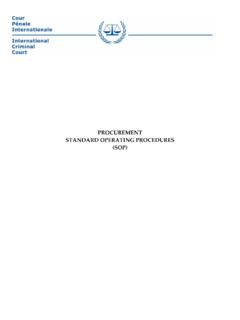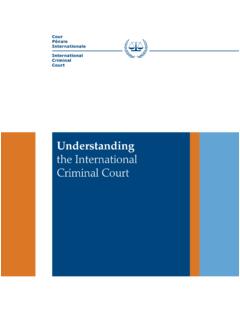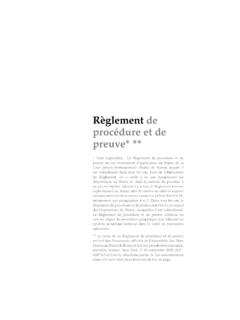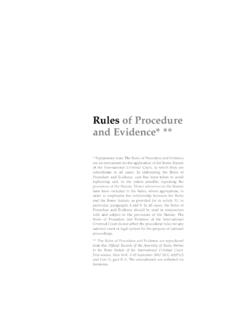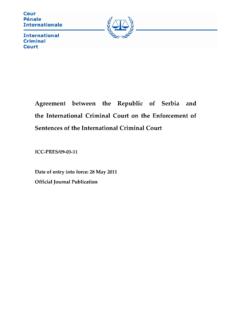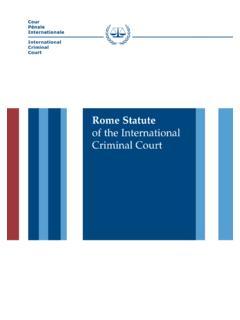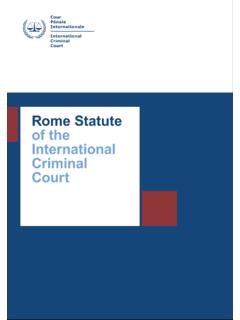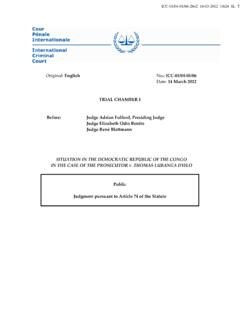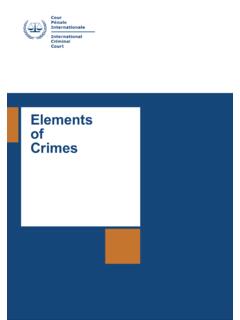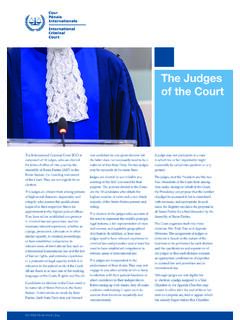Transcription of 3 Original: English .: ICC-01/04-02/06 Date: 9 June 2014 ...
1 No. ICC-01/04-02/06 1 9 June 2014 3 Original: English No.: ICC-01/04-02/06 Date: 9 June 2014 PRE-TRIAL CHAMBER II Before: Judge Ekaterina Trendafilova, Presiding Judge Judge Hans-Peter Kaul Judge Cuno Tarfusser SITUATION IN THE DEMOCRATIC REPUBLIC OF THE CONGO IN THE CASE OF THE PROSECUTOR V. BOSCO NTAGANDA Public With Public Annex Decision Pursuant to Article 61(7)(a) and (b) of the Rome Statute on the Charges of the Prosecutor Against Bosco Ntaganda ICC-01/04-02/06 -309 09-06-2014 1/98 EC PT No. ICC-01/04-02/06 2 9 June 2014 Decision to be notified, in accordance with regulation 31 of the Regulations of the Court, to: The Office of the Prosecutor Fatou Bensouda, Prosecutor James Stewart, Deputy Prosecutor Counsel for the Defence Marc Desalliers Caroline Buteau Andrea Valdivia Legal Representatives of the Victims Sarah Pellet Dmytro Suprun Legal Representatives of the Applicants Unrepresented Victims Unrepresented Applicants for Participation/Reparation The Office of Public Counsel for Victims The Office of Public Counsel for the Defence States Representatives REGISTRY Other Registrar Herman von Hebel Defence Support Section Victims and Witnesses Unit Detention Section Victims Participation and Reparations Section Other ICC-01/04-02/06 -309 09-06-2014 2/98 EC PT No.
2 ICC-01/04-02/06 3 9 June 2014 TABLE OF CONTENTS I. PROCEDURAL HISTORY .. 4 II. JURISDICTION, ADMISSIBLITY AND OTHER PROCEDURAL ISSUES .. 4 III. FINDINGS ON THE CRIMES 6 A. Findings on the Contextual Elements of the Crimes Against 6 B. Findings on the Contextual Elements of the War Crimes .. 12 C. Findings on the Specific Crimes in Counts 1, 2, 3, 4, 5, 7, 8, 10, 11, 12, 13, 17, 18 .. 13 D. Findings on the Specific Crimes in Counts 6, 9, 14, 15 and 16 .. 27 IV. FINDINGS ON INDIVIDUAL CRIMINAL RESPONSIBILITY .. 35 A. Article 25(3)(a) of the Statute Indirect Co-Perpetration .. 38 B. Article 25(3)(a) of the Statute Direct Perpetration .. 50 C. Article 25(3)(b) of the Statute Ordering .. 53 D. Article 25(3)(b) of the Statute Inducing.
3 56 E. Article 25(3)(d) of the Statute Contributing in any other way .. 57 F. Article 28(a) of the Statute Acting as a Military Commander .. 59 ICC-01/04-02/06 -309 09-06-2014 3/98 EC PT No. ICC-01/04-02/06 4 9 June 2014 PRE-TRIAL CHAMBER II (the Chamber ) of the International Criminal Court, (the ICC or the Court ) hereby renders this decision pursuant to article 61(7)(a) and (b) of the Rome Statute (the Statute ) on the charges of the Prosecutor against Bosco Ntaganda ( Mr. Ntaganda ). I. PROCEDURAL HISTORY 1. On 22 August 20061 and on 13 July 2012,2 two warrants of arrest were issued against Mr. Ntaganda. 2. On 22 March 2013, Mr. Ntaganda voluntarily surrendered to the Court3 and on 26 March 2013, the suspect made his first appearance before the 3.
4 On 10 January 2014, the Prosecutor filed the Document Containing the Charges (the DCC ),5 together with the list of evidence,6 and, on 17 January 2014,7 the Prosecutor also filed the consolidated in-depth analysis 4. On 24 January 2014, the Defence filed its list of evidence9 and in-depth analysis An amended version of the in-depth analysis chart was filed on 7 February 5. The confirmation of charges hearing (the Hearing ) was held from 10 to 14 February 6. On 7 March 2014, the Prosecutor13 and 1,120 participating victims14 lodged their final written submissions. On 8 April 2014, the Chamber received the final written Defence II. JURISDICTION, ADMISSIBLITY AND OTHER PROCEDURAL ISSUES 7.
5 The Chamber is satisfied that, pursuant to article 19(1) of the Statute, the present case continues to fall within the jurisdiction of the Court and is admissible. ICC-01/04-02/06 -309 09-06-2014 4/98 EC PT No. ICC-01/04-02/06 5 9 June 2014 8. With a view to rendering its final determination pursuant to article 61(7) of the Statute, the Chamber bases its findings on a comprehensive analysis of the evidence contained in the lists of evidence, the DCC, the in-depth analysis charts, the submissions made during the Hearing, and the final written submissions of the parties and participants. 9. As article 61(7) of the Statute dictates, the Chamber shall, on the basis of the hearing, determine whether there is sufficient evidence to establish substantial grounds to believe that the person committed each of the crimes charged.
6 Thus, to meet this intermediate evidentiary threshold,16 the Chamber must be thoroughly satisfied that the [Prosecutor s] allegations are sufficiently strong to commit [the person] for trial .17 Pre-Trial Chambers have consistently held that to meet the evidentiary burden of substantial grounds to believe , the Prosecutor must offer concrete and tangible proof demonstrating a clear line of reasoning underpinning [the] specific allegations .18 All findings of the Chamber in the present decision are made on the basis of the statutory standard applicable at this stage of the proceedings. 10. In its assessment of the evidence, the Chamber has been guided by articles 21, 64, 67 and 69 of the Statute and rules 63, 64, 68, 70, 71, 76 to 78, 121 and 122 of the Rules of Procedure and Evidence, as well as the evidentiary principles as interpreted in previous decisions of the 11.
7 The present decision represents the result of the Chamber s assessment of the Prosecutor s allegations in light of the evidence presented by the parties, as referred to in the endnotes to the present decision. The Defence challenges to the Prosecutor s evidence have been considered throughout this assessment. Where necessary, the Chamber provides a separate response to the challenges raised. ICC-01/04-02/06 -309 09-06-2014 5/98 EC PT No. ICC-01/04-02/06 6 9 June 2014 III. FINDINGS ON THE CRIMES CHARGED A. Findings on the Contextual Elements of the Crimes Against Humanity 12. On the basis of the evidence presented the Chamber concludes the following: There are substantial grounds to believe that as early as the beginning of August 2002, the Union des Patriotes Congolais/Forces Patriotiques pour la Lib ration du Congo (the UPC/FPLC )20 adopted an organisational policy21 to attack part of the civilian population,22 belonging to ethnic groups other than the Hema (the non-Hema )23 and to expel them from Ituri Province, in the Democratic Republic of the Congo (the DRC ).
8 Pursuant to this policy, between on or about 6 August 2002 and on or about 27 May 2003, the UPC/FPLC perpetrated a widespread and systematic attack24 against the non-Hema civilian population, in the locations identified in section A of the decision. Lacking sufficient evidence, the Chamber does not find substantial grounds to believe that such attack continued after on or about 27 May 2003. 13. The Chamber clarifies that the findings in paragraph 12 above are more specifically supported by the facts presented in each subsection of Section A. The UPC/FPLC as an Organisation25 14. The evidence indicates that the UPC/FPLC was an organisation with an established hierarchy headquartered in The UPC was formally established on 15 September 2000 when the UPC Statuts on its objectives and organisation were The President of the UPC had the power to issue decrees appointing and dismissing members of the organisation, including its executive 15.
9 The UPC s military wing, the FPLC,29 was formally established on or about 1 September 200230 and was headed by its Commander in Chief,31 Floribert Kisembo as Chief of Staff32 and Mr. Ntaganda as Deputy Chief of Staff in charge of Although the FPLC was not formally established before September 2002, the evidence demonstrates that the UPC, as a mouvement politico-militaire 34, ICC-01/04-02/06 -309 09-06-2014 6/98 EC PT No. ICC-01/04-02/06 7 9 June 2014 had a military wing before that UPC/FPLC troops were divided into sectors, brigades, battalions, companies, platoons and sections,36 headed by subordinate The UPC/FPLC had staff officers in charge of different matters, including administration, intelligence, operations, logistics and political Meetings were held in order to discuss and organise the Discipline was maintained and soldiers who deserted, refused to execute an order from above or committed offences were punished 16.
10 The UPC/FPLC also had an effective system of communication. Orders were transmitted down the chain of command from the headquarters to the field41 and superior commanders and chiefs of staff received daily reports42 through satellite phones43 and by way of Radio-phonie ( manpacks ).44 Messages transmitted by manpack were recorded in personal These channels of communication made it possible to inform the various levels of the UPC/FPLC of the situation on the ground and to convey instructions from 17. The UPC/FPLC also had the means and the capability to carry out military operations over a prolonged period of time. The UPC/FPLC had several sources of funding such as: (i) money from Gegere (north Hema)47 businessmen,48 (ii) money from gold or oil extraction contracts;49 and (iii) taxation imposed on the UPC/FPLC troops were numerous51 and well-trained as they received military training in several camps such as Mandro, Mongbwalu, Bule and The soldiers were well-armed with sufficient ammunition and several types of heavy weapons, such as rocket launchers, mortars and grenade launchers,53 mostly originating from 18.
